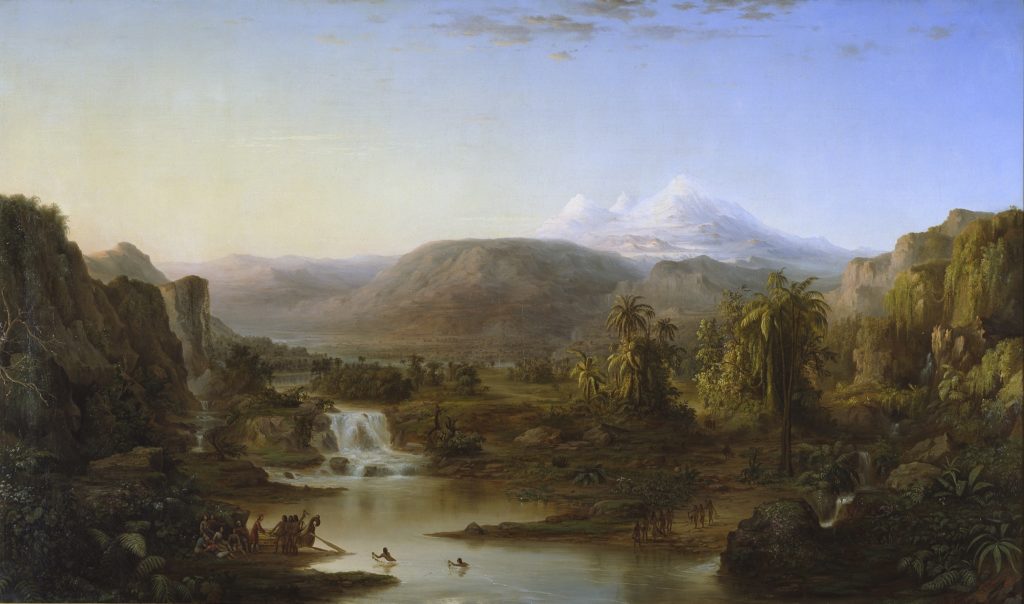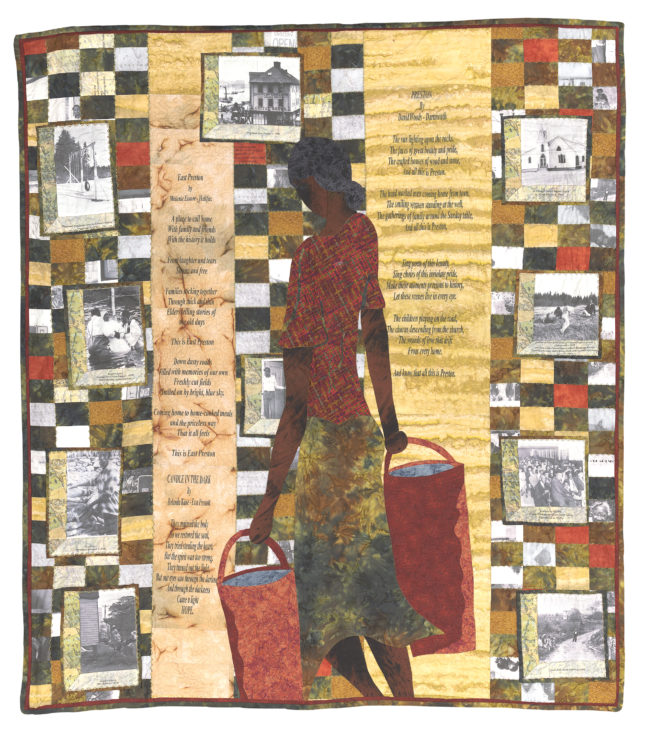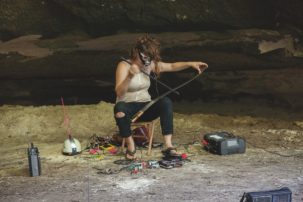Land of the Lotus Eaters (1861) is a powerful precursor to contemporary Black liberatory aesthetics. While conceived by its African American creator as a “great picture” to rival the Old Masters, Robert S. Duncanson’s lush landscape is no static utopia outside history. The painter has transformed a familiar scene from the Western literary canon into a speculative encounter between civilizations, a comment on the racial politics of his day. Today, there is an urgent need to recover Duncanson’s visionary canvas as a catalyst for Canada’s storied tradition of landscape painting, a tradition more often associated with fraught notions of whiteness. Unlike the “purified” landscapes of Lawren Harris, for instance, which stake a nationalist claim on the North, Duncanson’s Land of the Lotus Eaters doesn’t erase the signs of African and Indigenous presence—though its message would have been legible only to those able to decipher them.
Duncanson’s painting was inspired by British Romantic poet Lord Tennyson’s reinterpretation of an episode from Homer’s Odyssey. Scholar David M. Lubin and others have drawn attention to the work’s canny reimagining of Ulysses as a Christopher Columbus–like figure. Unlike Homer’s long-suffering protagonist, who eventually returns home, Duncanson’s explorer appears to stay in the company of the Indigenous inhabitants of a lotus land, which conspicuously resembles an imaginary American tropics more than the Mediterranean settings of its literary referents. Duncanson’s intervention metaphorically diverts Columbus’s cataclysmic course of “discovery,” gesturing instead toward alternate futures for people of colour on the eve of the American Civil War. In halting Ulysses’s homecoming, according to literary historian Peter Betjemann, Duncanson also bars the hero’s return to an economy based on slaveholding, a gesture that communicates the artist’s hopes for a permanent end to slavery in his lifetime.
The digressive storytelling of Land of the Lotus Eaters could also be interpreted in autobiographical terms, as an allusion to Duncanson’s own forthcoming odyssey of wartime self-exile. When first exhibited in the artist’s hometown of Cincinnati, the painting was accompanied by a statement boldly announcing a forthcoming world tour that would take it, and its fearless creator, first to Canada, with later stops in the British Isles—this amid the perils of a civil war then only recently begun. Displayed in Toronto in November 1861, Land of the Lotus Eaters must have received an enthusiastic response, since Duncanson mounted a second showing there in 1862.
Arriving in Montreal in 1863, Duncanson would be claimed as an honorary Canadian. This warm reception, and likely also the growing threat of a Confederate victory south of the border, encouraged him—like the Ulysses of Land of the Lotus Eaters—to linger long past his intended departure date. His two-year sojourn would change the course of Canadian art.
Prior to Duncanson’s 1864 Montreal presentation of Land of the Lotus Eaters, there was no established tradition of landscape painting in Canada. There were exceptional landscape painters, but no community of practitioners or unified style. The Düsseldorf-trained painter Cornelius Krieghoff, for example, one of the leading artists of the day, privileged foreground detail over atmospheric perspective. Duncanson’s atmospheric perspective would come to dominate a long line of Canadian landscape paintings produced in his wake, culminating in the romantic vistas of the Group of Seven in the early 20th century.
The new medium of photography played an enabling role in Duncanson’s innovations. When Duncanson arrived in Montreal, photographer William Notman was in the process of assembling reproductions of great artworks past and present for the album Photographic Selections (1863–65). Notman’s inclusion of Land of the Lotus Eaters alongside Duncanson’s romantic depiction of the harbour at Quebec City from 1863 showcased Duncanson’s astonishing range of abilities. Biographer Joseph Ketner relates that, upon receiving a proof copy of Notman’s photograph of Land of the Lotus Eaters, Tennyson himself enthused that Duncanson’s Homeric landscape, “though not quite my lotus land, is a land in which one loves to wander and linger.”
Notman’s landscape photographs promoted an image of the future Canada as a land abounding in both natural wonders and resources, helping to cement the project of Canadian confederation. Notman also stimulated new synergies between the craft of painting and the mechanical art of photography, employing painters such as Duncanson to create backdrops and retouch photographs. Duncanson had worked in a similarly hybrid capacity for the Cincinnati-based African American daguerreotypist James P. Ball. Prior to his departure for Canada, Duncanson helped to produce a spectacular panorama for Ball’s gallery, one that represented the history of slavery in the United States as well as acts of Black resistance and the Underground Railroad’s path to freedom in Canada. Duncanson was thus ideally poised to fulfill Notman’s dual—nationalist and intermedial—ambitions. Duncanson’s use of atmospheric perspective in turn reveals the imprint of his association with Notman.
Notman’s influence on other artists at this time is evident in the work of Otto R. Jacobi, whose Falls of Ste. Anne, Quebec (1865) is in fact a subtly idealized copy of a stereograph by Notman (for whom Jacobi worked part-time). Jacobi’s paintings are also a measure of Duncanson’s meteoric rise in Canada, as art historian Allan Pringle has shown. Jacobi’s monumental Emigrants Pioneering West (1865) was directly modelled on Land of the Lotus Eaters. Encouraged by Duncanson’s presence in Montreal, the romanticism of Jacobi’s later production typified a trend away from the bustling details of habitant life depicted by Krieghoff. The landscapes of Allan Edson, who worked as a bookkeeper for Duncanson’s Montreal dealer, A.J. Pell, also dramatize this change. As Edson’s first painting instructor, Duncanson made a lingering impact visible in his pupil’s Mount Orford, Morning (1870). Its own atmospheric depth recalls landscapes, such as Owl’s Head Mountain (1864), produced by Edson’s teacher during his self-exile in Montreal.
Finally departing from Montreal in the summer of 1865, Duncanson was likely accompanied by Edson (and possibly by Jacobi) on his subsequent tour of the British Isles. Coinciding with an abolitionist tide in the UK, he again found himself warmly received. Art historian Charmaine A. Nelson warns against misreading Duncanson’s success as evidence of progressive racial attitudes in Canada, “a space of virulent anti-black racism.” Nelson speculates that, like another artist-émigré of mixed ancestry in Canada, Grafton T. Brown, Duncanson had a light complexion that may have facilitated his “passing.” What is not in doubt is that Duncanson’s time in Canada set in motion a long tradition of romantic landscape painting, one in which his anti-slavery imaginary remains the enduring, if submerged, bedrock. Retrieving this history opens new possibilities for imagining Black futurities today.

 Robert S. Duncanson, Land of the Lotus Eaters, 1861. Oil on canvas, 1.34 x 2.25 m. © The Royal Court, Sweden. Photo: Alexis Daflos.
Robert S. Duncanson, Land of the Lotus Eaters, 1861. Oil on canvas, 1.34 x 2.25 m. © The Royal Court, Sweden. Photo: Alexis Daflos.







